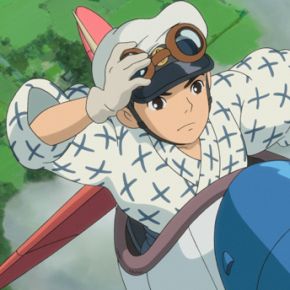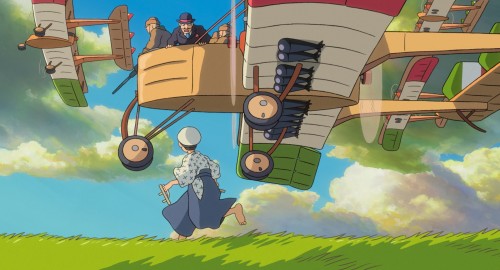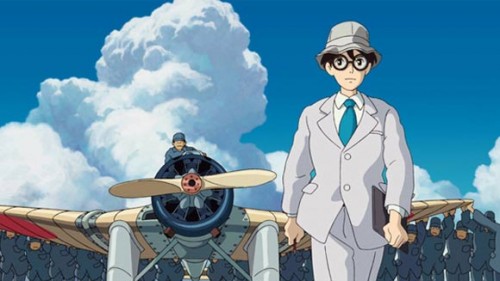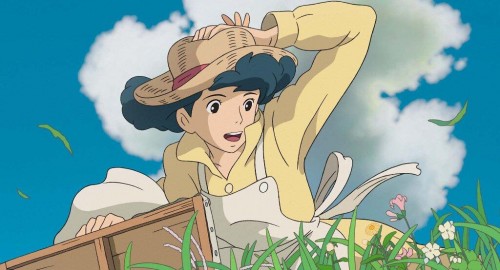
This one comes from Miyazaki guru Wenatchee the Hatchet:
Hayao Miyazaki’s latest film is unlike anything he has written or directed before. Famous the world over for stories that delight young and old alike, his newest film has stirred up controversy. After decades of being used to Miyazaki giving us films for children, what do we make of his semi-fictional account of the aviation engineer Jiro Horikoshi?
While some discussion and debate about Miyazaki’s possible endorsement of Japanese imperialism or failure to properly denounce the atrocities of imperial Japan have already been circulating, these debates tend to fixate on the “what” of Miyazaki’s film in a way that casts about for some foregone conclusion, which Miyazaki wishes to avoid. Though he’s known for directing feature-length ‘cartoons’, the moral universe of his films has never been cartoonish.
More reviewers have perceived in the director’s latest film a story of self-indictment, of an artist looking back on his life and taking stock of what he has sacrificed along the way. Or, to put it another way, Miyazaki tells us the story of a brilliant engineer who is thoughtful and thoughtless, caring and negligent, visionary yet naïve, and who idealistically designs a plane that will become legendary in the biggest global conflict in human history.
Miyazaki’s Jiro Horikoshi can be seen as a stand-in for Miyazaki himself, looking back on his life, but Jiro can be seen too as the aviation engineer who is a stand-in for his country and, at a larger level, for humanity itself. Miyazaki establishes early that Jiro is myopic, both literally and spiritually. His obsession with planes and his daydreaming cause him to forget, out of neglect and deliberation, a promise he made to his sister Kayo. His dream was once to fly planes, but he knows this dream is dead before it can be realized, because his vision is too poor. Unsurprisingly, in his first dream conversation with the great Italian engineer Caproni, he’s overjoyed to learn that Caproni has never once flown the planes he has designed. Caproni speaks to him of dreams, telling him that engineers can translate dreams into reality.
A crucial conversation beween Jiro and Caproni emerges in the second act. Caproni asks a young adult Jiro, “Would you choose to live in a world with or without the Pyramids?” This is the point at which we begin to understand what the heart of the film is about.
Would Jiro choose to live in a world in which his culture did not build pyramids? Again, this is a rhetorical question. Every culture has its incentive to build a tower at the plains of Shinar, a tower of Babel, a pyramid, but not every culture rationalizes and engineers the building in the same way. Jiro’s muse can be heard not just as a voice justifying Jiro, but also the ambitions of imperial Japan. Focus on the beauty of the vision – and not the blood that will be shed in realizing it. Jiro commits to designing his own pyramid despite knowing that pyramids are not just testaments to human ingenuity and vision, but additionally to our hubris and oppressiveness.
And so Jiro travels across the world and focuses more and more on aviation. In an elliptical inversion of coming-of-age stories, Jiro’s mental world becomes narrower and smaller the more broadly he travels the globe. His coworkers and friends regale him with the indignities of Japan in the wake of a massive earthquake and a depression. Jiro’s sister Kayo rebukes him for being inconsiderate, and his co-worker Honjo rebukes him for living in a dreamworld, oblivious to the reality that if Japan spent its war machine funding on food it could feed all its citizens. Jiro’s vision is set on designing the perfect plane.
Even his honeymoon with Naoko, his new wife, is little more than a few fleeting moments left over when Jiro isn’t designing his plane. He receives an exasperated, tearful rebuke from his sister about what a cruelly negligent husband and brother he’s been. Naoko is dying of tuberculosis and is constantly ignored by her husband who is pursuing his career and designing his beautiful plane.
By the film’s end Jiro is meeting yet again with his muse Caproni in a field of dreams and sharing, amidst the wreckage of all the planes that have crashed and burned, that not a single one of the planes he designed ended up coming back. Caproni simply shrugs and asks Jiro if he spent his years well. Jiro concludes that he has as a vision of his wife vanishes. Whether in designing the plane of his dreams or in marrying for fate and true love, Jiro sees that no sooner has a dream been realized in the real world then it must die. Both his wife and the plane of his dreams have died, and yet he is disturbingly satisfied with his life.
Miyazaki clearly did not set out to create a film that would please political partisans on any side. In fact if we attempt to define down Miyazaki’s story to just its period setting we may miss what he is aiming for, to let the microcosm of a particular period of Japanese history serve as a macrocosm for the various ways that people self-rationalize their ambitions and fail to count the costs of those ambitions.
Yet it would be short-sighted, like Jiro, to imagine that Miyazaki is necessarily condoning everything about his version of Horikoshi. When offered a path away from building a warplane by Castorp, Jiro both cannot and will not see what is before him. He forgets both on purpose and by accident and seals his own fate. Though strangers continually praise him for his kindness and generosity, those actually close to Jiro rebuke him for his neglect of family in the pursuit of his dream.
Jiro may not be guilty of any sins of commission (he didn’t use his planes, after all), but his entire life, in Miyazaki’s narrative, can be seen as one of sins of omission. He does not kill, but he does neglect. He does not design the deaths of people, just the planes that will be used to kill. It is his purity of vision that in itself becomes a rationalization for continuing on, even as friends and family and coworkers see all too clearly what Jiro’s designs will really be used for.
Miyazaki has said often enough in interviews he is a pessimist about the human condition and the future of the world. He refrains from sharing this pessimism in his films for children because he believes it is immoral to tell children there is no hope. But for an adult audience Miyazaki would not need to use kid gloves. If The Wind Rises is Miyazaki’s last film, he has ended his career with a cinematic slap in the face. Whereas in the past he has used his seemingly limitless array of fantasy sequences and visual flair to create fantasy worlds that invite us to appreciate the real world in new ways, The Wind Rises deploys nearly all of those techniques to reveal a man and a nation’s short-sightedness and self-justifying obsession. Beyond that, Miyazaki’s story becomes a fable of humanity’s endless capacity for self-delusion.
By the time we come to the end of the film, Jiro’s wistful musing on his success amid failure do not need to win a round of applause from us. If anything, Miyazaki invites to see both beauty and horror in the end of this film, inextricably juxtaposed as it is in the human heart. We can marvel at the beauty and elegance of Jiro’s plane in flight and shudder at how terribly he neglected his dying wife, who leaves him to die on her own in a sanatorium. Miyazaki’s vision of humanity is far bleaker than we would want to guess from his films Ponyo or My Neighbor Totoro. The Wind Rises is a fable telling us that ultimately, there is no culture, let alone an empire, that can be built apart from atrocity. Yet we know we live in a world where every culture – and every one – has pyramids to build. It’s all we know how to choose.

COMMENTS
Leave a Reply
















